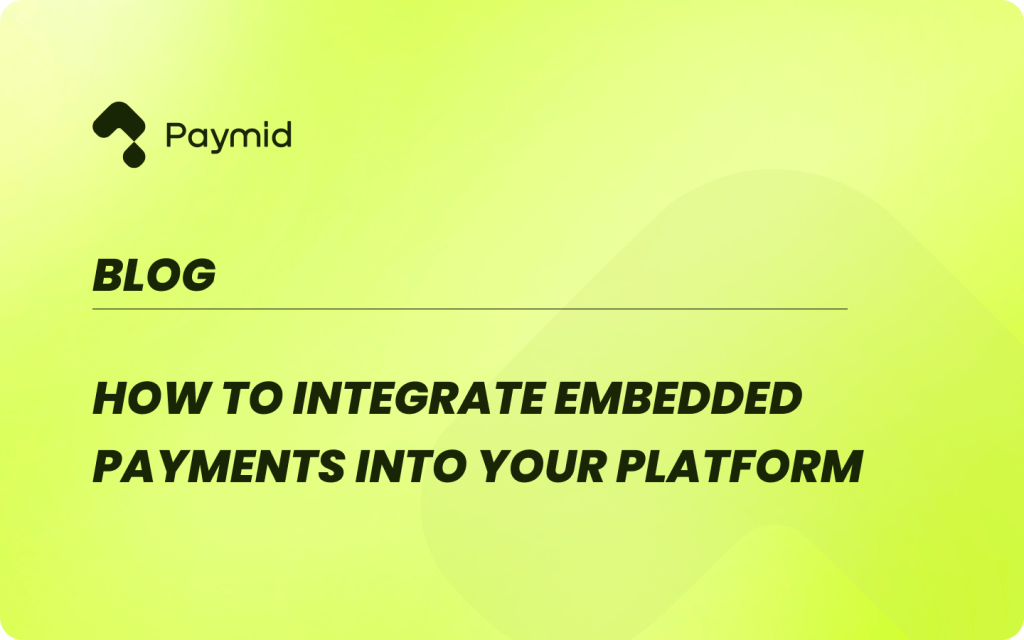How To Integrate Embedded Payments Into Your Platform?

Businesses are increasingly focused on optimizing payment processes to elevate customer experiences and drive growth. By integrating payment capabilities directly into platforms or applications, embedded payments offer a seamless and efficient solution. This approach not only streamlines transactions but also enhances user satisfaction, positioning companies to adapt swiftly in a competitive market.
Understanding Embedded Payments
Embedded payments refer to the seamless integration of payment processing capabilities directly into a software platform or application. This innovative approach allows users to complete transactions without leaving the platform’s ecosystem, creating a unified and frictionless experience[1]. The key feature of embedded payments is that they become an invisible part of the overall user journey, blending seamlessly with other functionalities.
Unlike traditional payment methods, embedded payments eliminate the need for redirects to external payment gateways or third-party services. This streamlined process enhances user satisfaction and has a positive impact on conversion rates, particularly in e-commerce scenarios where cart abandonment is a common issue[2].
Difference From Integrated Payments
While often used interchangeably, embedded payments and integrated payments have distinct characteristics[3]. Integrated payments involve connecting a payment system to existing software, but may still require users to interact with external payment gateways. In contrast, embedded payments offer a more cohesive experience by fully incorporating payment processing within the platform.
The primary distinction lies in the level of integration and user experience. Embedded payments provide a smoother, more intuitive process that feels like a natural extension of the platform[4]. This deeper integration allows for greater customization and control over the payment process, including compliance, security, and data management.
Benefits For Platforms And Merchants
Embedded payments offer numerous advantages for both software platforms and merchants. For platforms, this approach opens up new revenue streams by allowing them to monetize payment processing. It also enhances user loyalty and reduces churn by providing a comprehensive solution that meets all of a merchant’s needs within a single ecosystem.
Merchants benefit from a simplified onboarding process, as they can set up payments with a single click rather than managing multiple vendors[5]. This streamlined approach saves time and reduces complexity, allowing merchants to focus on their core business activities. Additionally, embedded payments often provide valuable data insights, enabling merchants to make informed decisions about their operations and customer behavior.
Steps To Integrate Embedded Payments
Choosing The Right Payment Provider
Selecting an appropriate embedded payment provider is crucial for seamless integration. Look for a provider with expertise in your industry and a track record of successful implementations. Read customer reviews from various sources and engage in direct discussions with potential providers[6].
Consider their value-added services, such as advice on industry-specific payment methods. Ensure the provider offers robust API integration capabilities and a straightforward setup process to minimize downtime and additional expenses.
API Integration Process
Once you’ve chosen a provider, the integration process begins. Your payment service provider (PSP) or payment gateway software provider will handle the embedding of payments into your platform.
They’ll obtain the necessary API credentials to integrate their payment API into your applications and internal tech stack[7]. This integration allows customers to initiate payments seamlessly within your digital wallets and platforms while providing you with easy access to data and analytics.
Testing And Quality Assurance
Thorough testing is essential to ensure the reliability and security of your embedded payment system. Create a sandbox environment to simulate real transactions without financial risks. This virtual playground allows you to perfect your payment gateway integration before going live. Implement both manual and automated testing approaches to cover various scenarios and use cases.
We also recommend focusing on functionality, security, and compliance testing to meet industry standards like PCI DSS[8]. Pay special attention to refund processing, tokenization for secure data storage, and the overall transaction flow. By conducting comprehensive testing, you can identify and resolve issues before they affect your customers, ensuring a smooth and secure payment experience.
Optimizing The User Experience
Optimizing the user experience is crucial for the success of embedded payment solutions. By focusing on key aspects such as checkout flow, security measures, and payment options, businesses can significantly enhance customer satisfaction and boost conversion rates[9].
Designing A Seamless Checkout Flow
A well-designed checkout process is essential for reducing cart abandonment and increasing sales. The golden rule is simplicity, minimizing the number of steps and screens customers must navigate. Implementing a single-page checkout can be highly effective, as it streamlines the process and reduces the risk of customers abandoning their carts.
By eliminating unnecessary information requests, such as shipping addresses for digital products, businesses can see remarkable improvements in conversion rates. For instance, removing the billing address from checkout has been shown to increase conversions by up to 35.1%[10].
Implementing Security Measures
Security is paramount in embedded payment systems. Implementing robust encryption protocols, tokenization techniques, and compliance with industry standards like PCI DSS are essential for protecting sensitive payment information.
Displaying security badges prominently and using HTTPS can reassure customers that their data is safe, fostering trust and professionalism. Advanced fraud detection capabilities, such as machine learning algorithms that analyze transaction patterns, can help prevent fraudulent activities before they impact the business[11].
Offering Multiple Payment Options
Providing a variety of payment methods caters to different customer preferences and can significantly impact conversion rates. Including popular options like credit and debit cards, PayPal, and mobile wallets such as Apple Pay or Google Pay makes the checkout process more accessible and convenient for a broader range of customers.
Data shows that adding one-click checkout options can increase conversions by an industry-leading 29.7%, highlighting the importance of offering diverse and user-friendly payment solutions[12].
Read More:
- Top Tips for Managing Venmo Recurring Payments Efficiently
- Average Cart Abandonment Rate: Trends, Impact, & Solutions
- Network Tokenization: Benefits, Process & Implementation
- Cascading Payments Explained: Benefits and Techniques
Measuring Success And Future Trends
Key Performance Indicators
To gauge the effectiveness of embedded payment solutions, businesses must track crucial metrics. Transaction volume and value are fundamental indicators, providing insights into overall usage and financial impact. The payment acceptance rate reveals the success of transactions, while the chargeback ratio helps identify potential fraud or customer dissatisfaction.
Customer lifetime value (CLV) offers a long-term perspective on the profitability of different customer segments[13]. By monitoring these KPIs, companies can optimize their embedded payment strategies and enhance customer experiences.
Analyzing Transaction Data
Leveraging data analytics is a game-changer for embedded payments. By examining transaction patterns, businesses can gain valuable insights into customer behavior and preferences[14]. This information allows for more targeted and effective payment solutions.
Advanced analytics tools can also help in fraud detection and prevention, enhancing the security of embedded payment systems. Companies can use this data to streamline their payment processes, reduce processing times, and decrease transaction costs, ultimately improving overall efficiency and customer satisfaction.
Emerging Technologies In Embedded Payments
The future of embedded payments is shaped by cutting-edge technologies. Artificial Intelligence (AI) and machine learning are revolutionizing fraud detection and personalized customer experiences. Blockchain technology offers enhanced security and transparency for transactions.
The rise of digital wallets and mobile-first experiences is transforming how consumers interact with payment systems. These advancements are not only making embedded payments more efficient and secure but are also opening up new possibilities for innovation in the fintech sector[15].
How Are Embedded Payments Transforming Business Transactions?
Embedded payments are reshaping the way businesses handle transactions, offering a seamless and efficient experience for both platforms and customers. By integrating payment capabilities directly into software platforms, companies can streamline their processes, boost user satisfaction, and unlock new revenue streams. This approach has a significant impact on various industries, from e-commerce to B2B services, by simplifying complex payment workflows and providing valuable data insights.
As technology continues to evolve, the future of embedded payments looks promising. With the rise of AI, blockchain, and mobile-first experiences, we can expect to see even more innovative solutions in this space. To stay ahead of the curve, businesses should keep an eye on emerging trends and be ready to adapt their strategies accordingly. By focusing on user experience, security, and data analytics, companies can make the most of embedded payments to drive growth and stay competitive in an ever-changing digital landscape.

